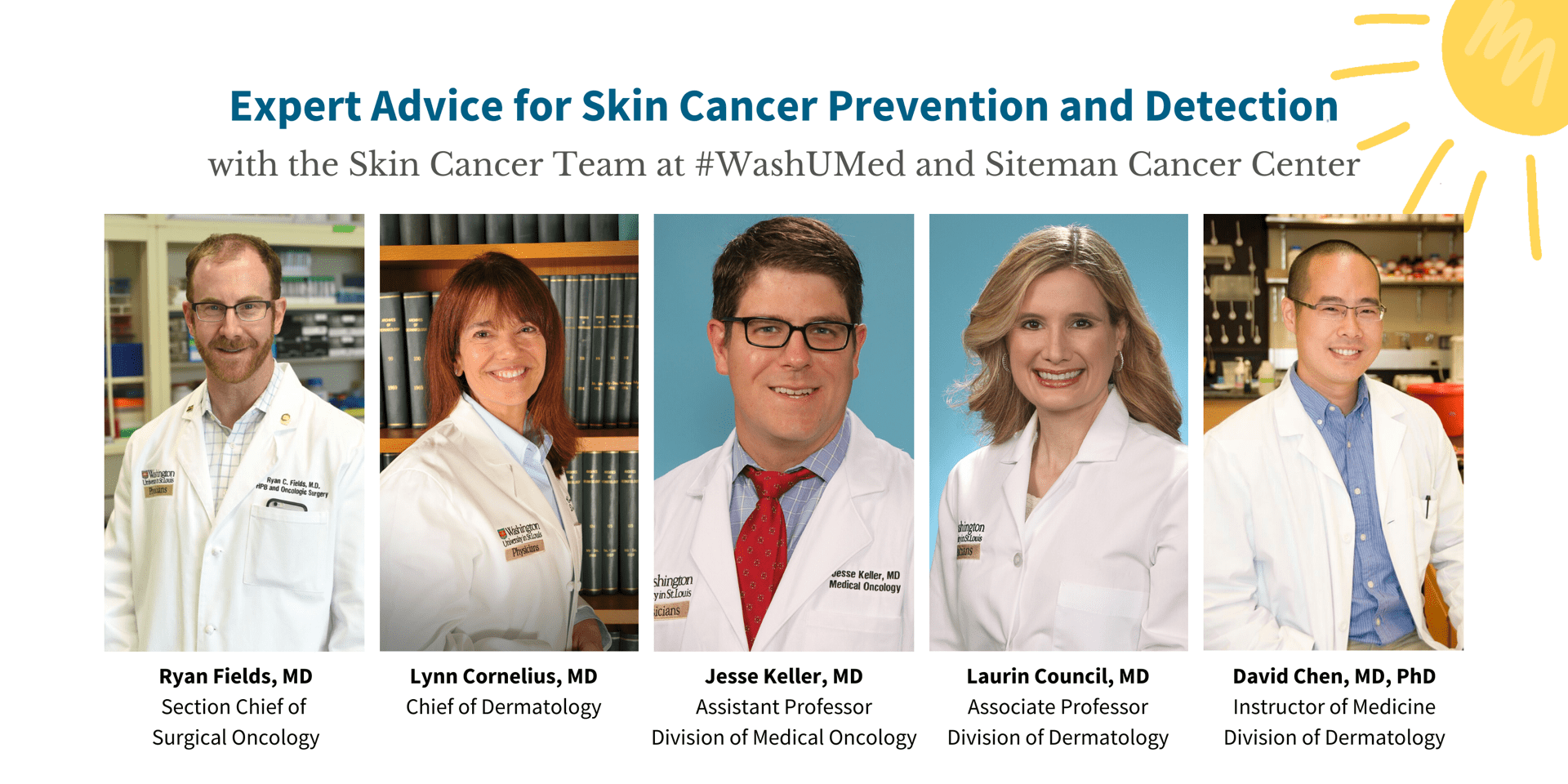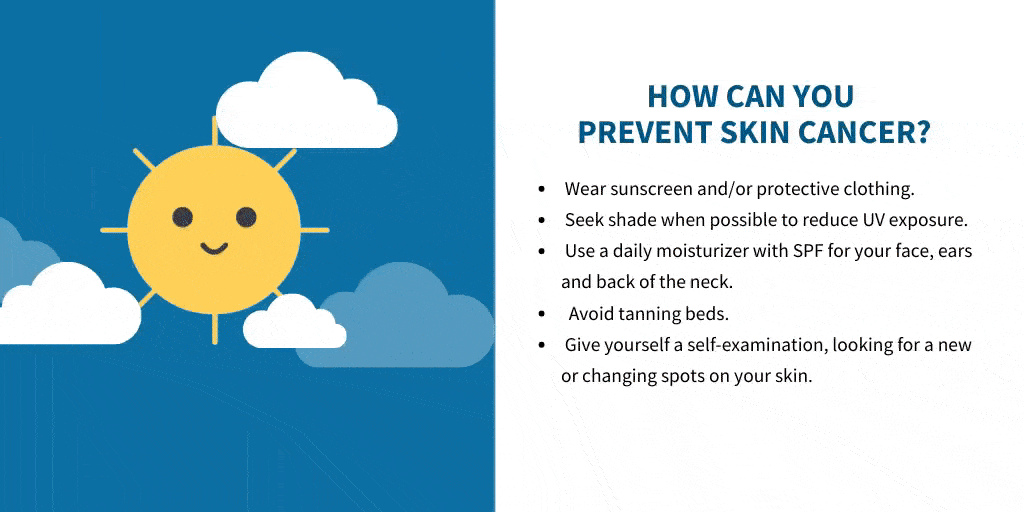
As the days grow warmer and brighter, outdoor activities like running, biking, swimming and yardwork all increase in popularity. These kinds of activities are an important part of our lives; outdoor exercise is beneficial to physical and mental health, and spending time in the sun also helps the body synthesize vitamin D.
Too much exposure to ultraviolet (UV) radiation from the sun or tanning beds, however, can be harmful to the skin. UVA and UVB radiation damages the DNA in skin cells, producing mutations, that can lead to skin cancer. This is especially concerning because, according to the Skin Cancer Foundation, five or more sunburns doubles the risk of melanoma, and more than two people die of skin cancer every hour.
The Skin Cancer Team at Washington University School of Medicine in St. Louis and Siteman Cancer Center has advice on how to prevent and detect skin cancer while safely enjoying the outdoor activities of daily life.
“We don’t want people to be fearful of the sun and sit indoors for the rest of their lives,” says Ryan Fields, MD, Section Chief of Surgical Oncology.
Fields, along with Lynn Cornelius, MD, Division Chief of Dermatology; David Chen, MD, PhD, Laurin Council, MD, Physicians in the Division of Dermatology; and Jesse Keller, MD, Assistant Professor in the Division of Medical Oncology, provide advice on skin cancer prevention and detection.

Prevention
The most effective way to prevent skin cancer is by protecting your skin from UV from the sun or artificial sources, such as tanning beds.
“The highest UV intensity from the sun occurs between 10 am and 4 pm,” says Cornelius. “These are the best hours for you to avoid sun exposure, and the most important times to protect your skin.”
The Skin Cancer Team recommends using sunscreen and protective clothing, and avoiding tanning beds.
Sunscreen
“What I usually tell my patients is that they should find a sunscreen that they like and will actually put on every day,” Chen says. “There are a lot of factors that determine if people will use sunscreen, including the texture, fragrance and appearance after application.”
The Skin Cancer Team offers a few guidelines that are important:
- Sun protection factor (SPF): For fair-skinned people who are prone to sunburn, SPF 30 or higher is best. The bottom line is that you need to apply liberal amounts of sunscreen at least every 2 hours when you are outside, and more often if participating in water activities.
- Broad spectrum: This means that the sunscreen protects from both UVA and UVB. UVA rays cause premature aging, while UVB rays cause burning. Protection from both is important because they both contribute to skin cancer development. The packaging will say if it is broad spectrum. In general, mineral sunscreens (zinc oxide, titanium dioxide) are broad spectrum, while chemical sunscreens require mixtures of different ingredients to achieve broad spectrum coverage.
- Amount used: The effective SPF of a sunscreen can be greatly diminished by inadequate application. The most important thing is to ensure proper, liberal coverage. For example, with a lotion, you should be using 1 ounce for your entire body every 2 hours. For a sunny day on the beach, you may use up an entire bottle of sunscreen if you are applying it as recommended!
Fields is an advocate for the use of sunscreen because he knows firsthand how harmful and uncomfortable sunburn can be.
“I’m fair-skinned, with red hair and blue eyes. I sunburn very easily,” Fields says. “My burn time is about 30 minutes. If I’m out in the sun for 30 minutes, even if it’s a little overcast, I’ll get a sunburn. That’s my threshold for if I’m going to put on sunblock.”
Council emphasizes that there are two types of risks associated with skin cancer: risks that we can control, and risks that we cannot. Exposure to ultraviolet light is the single-most modifiable risk factor for the development of skin cancer.
Like Chen, Fields emphasizes the importance of finding the product you are most comfortable using.
“If you have children, one type of sunscreen might work best for them, whereas you prefer a different product,” Fields says. “If you have body hair, you might be more comfortable with a certain kind of sunscreen. It’s not that one brand or product is best, but that you think about those stipulations and your personal preference.”

Protective Clothing
Another option the Skin Cancer Team recommends is UV protective clothing. These garments have an Ultraviolet Protection Factor (UPF), which you can think of like an SPF for your clothes. The major benefits are that the coverage is consistent and you don’t have to worry about reapplication of sunscreen if you are wearing the UPF clothing.
“We usually recommend a UPF of 50,” Cornelius says. “The number indicates the fraction of the UV rays that can go through the fabric.”
Fields recommends adding a wide-brimmed hat and sunglasses to other UPF clothing for best protection. This helps protect the head, ears and eyes from UV while spending time outdoors.
Making Prevention Part of Your Routine
It is never too late to start developing good habits for protecting yourself from UV damage.
“Starting a good skin cancer prevention routine involves getting to know your skin, how sensitive it is to the sun and what spots are on your skin,” Chen explains. “In general, if there’s a spot that is growing or changing on your skin, or a sore spot on your skin just doesn’t seem to heal, you should bring this to your doctor’s attention. Our methods of detection and treatment have rapidly advanced in recent years, and continue to improve. Still, prevention and early detection are not only the most important factors that decrease risk of harm from skin cancer, they are also steps that you can actively take in your everyday life.”
The Skin Cancer Team suggests making the following things part of your skin cancer prevention routine:
- Wear sunscreen and/or protective clothing.
- Seek shade when possible to reduce UV exposure.
- Use a daily moisturizer with SPF for your face, ears and back of the neck. Fields notes that there are several unscented products for people who do not want a perfume smell.
- Avoid tanning beds.
- Give yourself a self-examination, looking for any new or changing spots on your skin.
Detection
Early detection and treatment are very important to the successful removal of skin cancer. Some of the deadliest forms of skin cancer, such as melanoma, can spread if left untreated.
“You should check your skin regularly,” suggests Keller. “You should also address concerning spots with your dermatologist or doctor as soon as possible. In general, the sooner we remove the cancer, the better.”
The ABCDE of Skin Cancer Detection
Self-examination is an easy first step in detecting possible melanomas and other types of skin cancer. Whether it is because of the start of swimsuit season, or simply as part of your prevention routine, the Skin Cancer Team recommends looking out for these 5 signs of skin cancer.
Asymmetry: If a spot or lesion does not look the same all around, or is not symmetrical.
Border: Jagged or uneven borders to a lesion or spot on the skin.
Color: Dark or multiple colors on a spot might be indicative of melanoma.
Diameter: Spots or lesions that are bigger than a pencil eraser might be concerning.
Evolving: Anything that is changing or growing should also be brought to medical attention.
Do Not Wait
Even a small spot on the skin could be a sign of melanoma or other types of skin cancer. The Skin Cancer Team urges anyone with a spot or lesion that fits the ABCDE criteria to see their doctor. Medical centers at the School of Medicine and Siteman Cancer Center are following proper health and safety guidelines to ensure that patients can safely and confidently bring their concerns to a physician.
Council states that a board-certified dermatologist can evaluate a new lesion to determine whether or not it needs a biopsy. If you live in an area without a board-certified dermatologist, your primary care physician may be able to do the same. You can request a “full-body skin examination” to have your skin lesions checked-even ones on your back or the backs of your legs where you may not be able to typically see.
“A dermatologist will examine the spot in question,” Chen says. “It may seem quick, but the evaluation integrates a lot of information, and experienced dermatologists may evaluate several hundreds or thousands of patients each year.”
The dermatologist will also ask about your family and personal history of skin cancer. Both of these factors can greatly increase a person’s risk for developing skin cancer.
“If a spot is suspicious for skin cancer,” Chen says, “the doctor will likely perform a biopsy in order to confirm the diagnosis and prescribe the appropriate treatment.”
World Class Leaders in Skin Cancer Treatment
The Skin Cancer Team at the School of Medicine and Siteman Cancer Center consists of dermatologists, surgeons, medical oncologists, pathologists, nurses, councilors and caregivers and patients. Depending on the type and stage of skin cancer, the team has several treatment options available, including surgical excision, immunotherapy, chemotherapy and targeted therapy individualized to that patient’s case.
The goal of this team is to provide a full range of cancer diagnosis and treatment options led by specialists at the top of their field when needed, and to educate and monitor patients to reduce the risk of developing skin cancer.
“This is such a center of excellence for skin cancer,” Fields says. “We have a team who focuses only on skin cancer, and that’s their specialty. I like to run, I like to bike ride, I like to spend time with my kids in the back yard. We don’t want people to avoid those kinds of activities. We just want people to be sensible about not getting sunburns, not getting to the point where you’re looking at yourself in the mirror and see that you have a “farmer’s tan,” which probably means you’re not using sunblock as you should. If you do come to the Skin Cancer Team with a melanoma or other skin cancer, you’re getting world-class leaders in the field who are involved in national and international treatment recommendations, cutting-edge clinical trials and research on new therapeutics and diagnostics and prevention techniques. You just get the best of the best.”
More information on skin cancer prevention, detection and treatment, as well as a complete listing of physicians on the Skin Cancer Team, is available at Siteman Cancer Center.